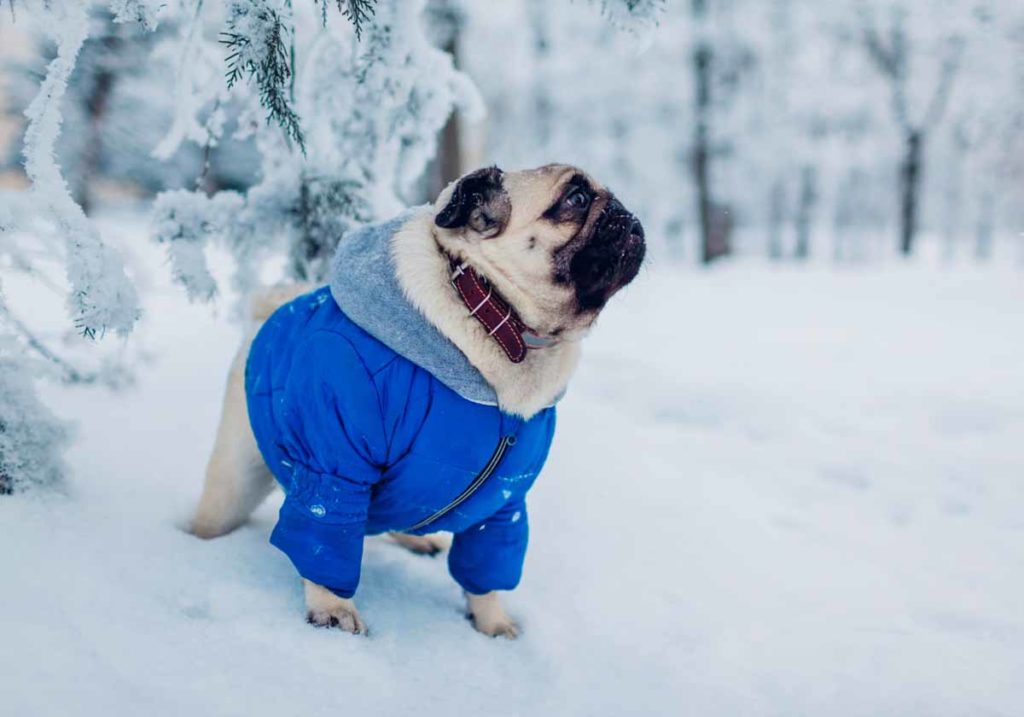Reviewed by: Dr. Robert Menardi, DVM
With winter and cold weather upon us, many pet parents wonder how cold is too cold for their dogs to be outside. Even though dogs are covered in fur, it is important to remember that their entire body is exposed to the weather, and a good guideline is if it is too cold for humans to be out, it is too cold for our dogs.
As the temperatures drop, understanding how our four-legged friends are affected by the weather and what we can do to keep them safe and happy will make sure everyone has a great winter.
How long can my dog stay outside?
This can be very breed-dependent, as varieties in dogs’ size, coat, and age have an impact on their ability to deal with cold.
- Age: Puppies and senior dogs are less cold tolerant than healthy adult dogs and should be watched carefully as the temperatures drop.
- Size: Small dogs tend to be less able to stand cold temperatures than larger dogs as they have smaller mass and can be thinner, without the insulating fat that many larger dogs have.
- Coat type: Coat type has a large effect on how long dogs can be in the cold. Breeds with extremely thin coats such as Vizslas, Chihuahuas, and greyhounds have just a single layer of fur that offers little warmth and protection from the elements. These dogs cannot be out for very long in very cold weather and often benefit from wearing coats or sweaters to stay warm.
- Breed: There are breeds that are much more suited for the winter weather like Huskies, Samoyeds, Newfoundlands, and other thick-coated breeds who thrive in the cold and snow. These breeds originated in cold-weather areas and have adaptations like thick, double-coated fur to keep them warm. They often have other characteristics like furry paws, compact bodies, and small, almond-shaped eyes that allow them to withstand cold temperatures. Even with these cold-weather adaptations, it is important to remember that conditions can be too cold for these dogs. Knowing and watching for the danger signs will help protect your dog.
- Weather: Other factors that influence how long your dog can be out in the cold include weather elements. A cloudy day will chill a dog faster without any chance to be warmed by the sun. If your dog gets wet, either because it is raining or snowing, they can become chilled quickly, and a cold wind can quickly make it feel like the temperatures are much lower.
Given all of these factors, a rough guideline is that most dogs are fine in temperatures above 45 F. Thin coated dogs, puppies, and older dogs should be watched closely as the temps fall below freezing (32 F). Under 20 F, dogs face a risk of hypothermia or frostbite if they spend too long outside.
Signs that it is too cold for your dog:
Conditions can quickly become too cold for your dog, so you should be aware of a few behaviors that mean they are getting too cold and need to be brought inside and warmed up. These changes happen sooner than frostbite or hypothermia. A few signs to look out for include:
- Picking up their paws, walking gingerly, sitting down, and being generally unwilling to play
- Shivering or seeming unhappy
- Breathing slowly
- Whining
- Tucking their tail
How to keep your dog warm:
- If possible, try to keep your dog’s fur a little longer during the cold weather months. Their fur provides extra insulation and helps keep warm air close to their body.
- Dog sweaters and jackets can help your active dog stay outside longer this winter. Clothing designed for dogs will allow for full mobility and won’t have long strings or extra fabric that can get caught or cause them to trip. Be sure your dog’s clothing is dry before heading outside to prevent them from becoming dangerously chilled.
- Protect their paws: Winters can be cold, long, and dry—even with lots of snow and sleet outside; the air tends to dry out in the winter because cold air can’t hold as much moisture as warm air. Humans wrap their feet up in thick wool socks and waterproof boots to protect them from the cold ground, but they often overlook their dog’s needs. While paw pads are thicker than the bottom of our feet, that doesn’t mean they’re safe from frozen ground and winter debris. Some dogs with longer fur on their feet can also get chunks of ice between toes and pads, which can be uncomfortable or harmful.
Salt & Other Ice-Melting Chemicals
To prevent humans from slipping on ice, various chemicals and products are used in order to melt it during cold months. And while ice can be dangerous for dogs, especially if their nails are long or they have mobility issues, the chemicals used to melt the ice pose a risk. Dogs can irritate or burn their paws by walking on salt or ice-melt products, and if they lick or chew their paws, they could further irritate the skin or ingest harmful chemicals.
If you use an ice-melt at your house, opt for something labeled “pet-safe”—beware, however, that pet-safe doesn’t mean it can be ingested or come into topical contact with your dog’s skin without any risk of irritation. The longer the topical exposure to the ice-melt or the more ingested, the more likely there is to be an issue. Even if you use pet-safe products, following the steps below is essential to keep your pup as safe, healthy, and happy as possible this winter.
Prevention
Maintaining proper humidity, generally considered 30-50%, in your home during the winter months promotes skin health for both you and your dog. A good humidifier will keep your living space in this range. Staying hydrated is also crucial for maintaining your dog’s skin health, including the skin of their paw pads, which becomes especially important in dry, cold climates. If your dog drinks plenty of water and if your house stays at an appropriate humidity level, you’ll be setting your dog’s paws up for success this winter.
Just as humans use moisturizers to prevent or soothe dry skin, dogs can benefit from a dog-specific moisturizer or paw wax. Apply a small amount at a time to the pads of their feet, massaging it in thoroughly. To get your dog used to you touching their paws like this, you can slowly and gently introduce them to the idea of a paw massage. If your dog seems comfortable with you touching its paws for an extended period, you can go ahead and try it with the product you’ve chosen.
Protection
Two suitable barriers of protection are paw wax and paw boots. Before you head out into wintry weather, coat their paw pads liberally with a paw wax. Once you’ve rubbed a layer of wax into their paw pads, you can put a set of paw boots on. These extra layers of protection will help seal the skin off from whatever your dog steps on.
While you’re outside, check your dog’s paws regularly to ensure the boots haven’t fallen or shifted position. Not all dogs like or will tolerate paw boots, so starting with a few minutes and gradually extending the time wearing the boots can help them adjust.
When evaluating paw boots, there are a few features to look for that will make them effective:
- Waterproof materials
- Non-slip soles
- Insulation
- Secure straps
- Proper size for your dog
When you get back inside, take off the boots, wipe off the wax, then (re-)apply a small amount of wax to maintain skin moisture.
Use these preventative measures when spending time outside with your dog on cold days, check their paws often, consult your veterinarian if you see anything out of the ordinary, and make playing in the snow fun for both of you! Your dog will tell you if he wants to go back inside or is uncomfortable, so the most important tip is to pay attention to your dog’s behavior and body language, which will tell you when cold is too cold.








